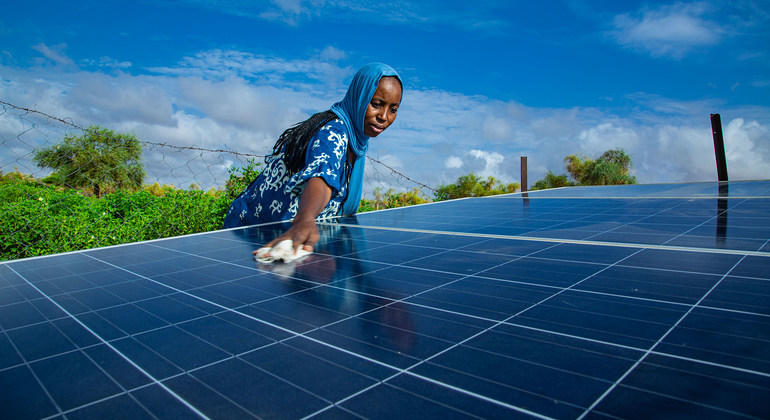Mark Carney, the UN Special Envoy for Climate Action and Finance, assembled the Glasgow Financial Alliance for Net Zero, a group of bankers, insurers and investors who now have committed to put climate change at the centre of their work.
But what exactly does this deal mean?
“The core message today is that the money is there, the money is there for the transition, and it’s not blah blah blah”, Mr. Carney told delegates during a COP26 climate finance event.
The former Governor of the Bank of England underscored that he sees Net Zero as the critical infrastructure of the new financial system.
“It is about client focus, going to where the emissions are to help get them down. So, companies that have plans in place to reduce the emissions, will find the capital, those who don’t won’t. So highly recommend getting those plans in place”, he explained.
The commitment comes with a pathway by which the companies involved, included most of the major Western banks, must use science-based guidelines to reach net-zero emissions by 2050, and commit to interim goals towards a 50 per cent reduction by 2030, and even a 25 per cent reduction in the next five years.
This means adjusting their business models, developing credible plans for the transition, and then implementing them.
“And then critical annual reports. We will have the feedback about who is doing well, who needs to do better, and also in terms of policy, what’s there and what’s not”, Mr. Carney highlighted.
🎥 Watch the interview
Why do we need the private sector for climate funding?
According to the Alliance, private finance can help fund private sector initiatives and turn billions committed to climate investment through public channels into trillions of total climate investment. But unlocking systemic change will require collaborative, ambitious commitments, and near-term action across the entire financial system.
“Up until today there was not enough money in the world to fund the transition; this is a watershed,” Mr. Carney told the COP plenary.
According to Patricia Espinosa, the Executive Secretary of the UN Framework Convention on Climate Change (UNFCCC), there is no doubt that there must be a deep transformation of the world’s economy and the private sector must be part of it.
“The private sector is realizing that climate risks are very important for their portfolios and they need to align them to a more sustainable way of doing things,” she told journalists at a press conference.
Meanwhile, for the head of the UN Environmental Programme (UNEP), the new alliance with the private sector is “an absolutely critical cause.
“Our Emissions Gap Report shows it: there are about 500 gigatons left (of CO2 emissions), with the current NDCS (national emission reduction plans), we have taken 4 gigatons (from emissions), but we are emitting 55 a year. This doesn’t compute… There are some real opportunities for the finance sector, we need to stay out from coal, oil, and gas,” Inger Andersen explained.
Businesses respond
Guenther Thallinger, from the German multinational financial services company Allianz expressed their commitment to the Glasgow Financial Alliance.
“It all starts with changing the decision making that we all have as financial institutions. Climate impact needs to be integrated in the decision making, that’s why interim targets are so important. We have all set this type of targets, and it’s very important that they are fairly short term”, he told a panel reunited at the Action Zone of COP26.
“We are literally here creating a new industry, new ground rules for a new industry that is prioritizing climate action. For that we need all the traditional things, we need measurement, we need metrics, we need reporting…I want to take the opportunity to share that we will be announcing our first round of interim targets”, added Audrey Choi, Chief Sustainability Officer of Morgan Stanley.
And what’s up with the public sector money at COP26? Delayed for now…
At COP15 in 2009, climate finance funding of $100 billion a year by 2020 was agreed to support resilience, adaptation, and energy transitions in developing countries. The promise is now officially delayed to 2023.
However, COP26 President Alok Sharma delivered some good news: 90 per cent of the world’s economy is now covered in a net-zero target. Only 30 per cent was committed at the beginning of 2020.
“It is regrettable that we are highly unlikely to meet the $100 billion dollar goal in 2021, but based of the information submitted by donors, the analysis shows that developed countries will make significant towards the 100-billion-dollar goal in 2022, and I believe it also provides confidence that we will meet it in 2023”, he said during a press conference on Wednesday.
Earlier in the day, and referring to the same matter, UK Chancellor Rishi Sunak urged developed countries to boost their support to developing countries, including by helping them tap into the trillions of dollars committed to net zero by the private sector.
However, UN climate chief Patricia Espinosa stressed that some advancements have been made in this regard.
“United States joined Britain, France, Germany and the European Union in a multibillion-dollar partnership to support South Africa finance equal transition from coal. This initiative is valued at 8.5 billion over all”, she said.
She added that Japan and Australia have also announced commitments to double their adaptation finance, and United States, Switzerland and Canada also significantly raised their financial support to adaptation.
Moreover, countries have also committed to funnel $12 billion for forest-related climate finance between 2021-2025.
“New commitments have been made by Spain, Ireland, Luxembourg, so I do hope that by the end of this conference we can really get to the goal of the 100 billion maybe in 2022”, Ms. Espinosa urged.





